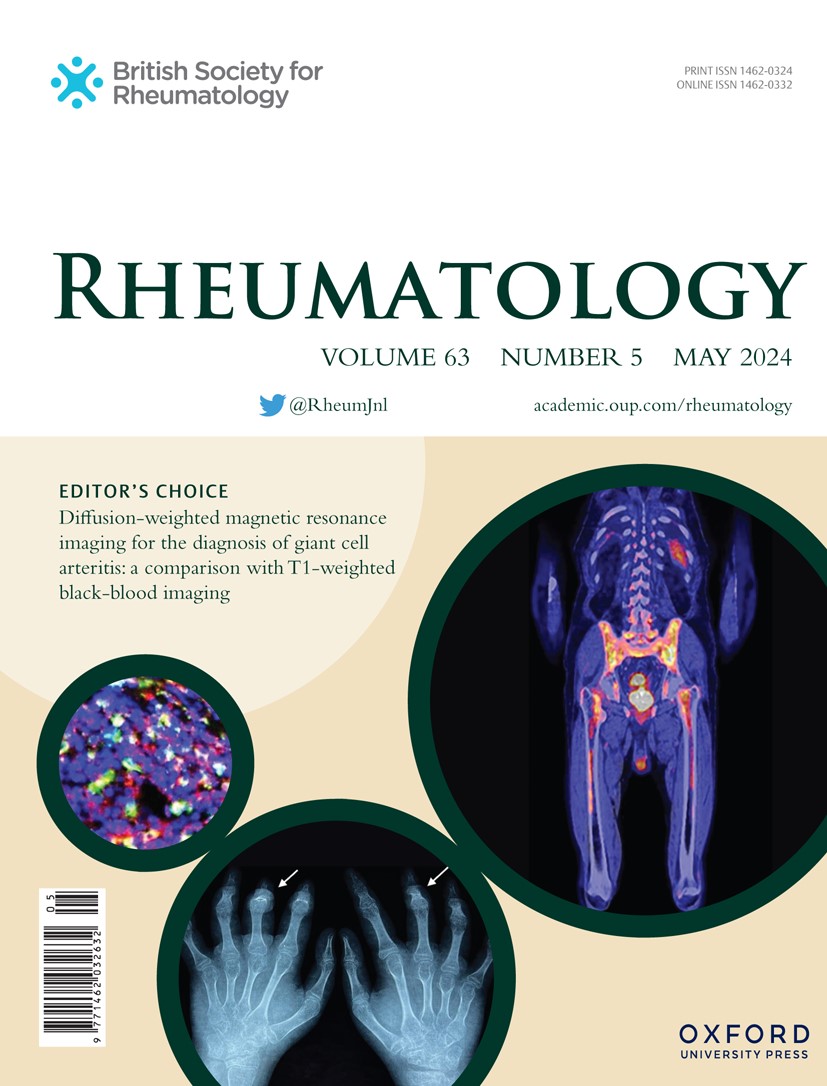Cartilage turnover, but not novel synovial collagen marker, is associated with joint damage progression in osteoarthritis patients.
IF 4.4
2区 医学
Q1 RHEUMATOLOGY
引用次数: 0
Abstract
OBJECTIVE To investigate the relative contribution of cartilage and synovial turnover to predict progression in patients with knee or hip osteoarthritis (OA). METHODS 449 patients with symptomatic knee or hip OA (mean age: 62 yr, 62% women) with a Kellgren-Lawrence (KL) score > =2 from the prospective KHOALA cohort study were investigated. Progression was defined as a one-point increase in the KL scores from knee or hip radiographs and/or a joint replacement during 5 years follow-up. The association of baseline urinary CTX-II and serum Col 3-4, biochemical markers of cartilage and synovial turnover, respectively, with progression was assessed by multivariable discrete-time survival models. RESULTS Increased baseline CTX-II levels were associated with an increased risk of knee and/or hip OA progression, patients with levels in the fourth quartile having an odds-ratio (OR; 95%CI) of 2.57 (1.57-4.18) compared with subjects with levels in first quartile, after adjustment for demographical and OA clinical variables and KL scores. When analyses were restricted to patients with knee or hip OA progression only, similar findings were obtained with corresponding ORs (95% CI) of 2.36 (1.32-4.21) and 3.39 (1.42-8.11), respectively. There was no significant association of baseline Col 3-4 and the risk of knee or hip progression. CONCLUSIONS Increased urinary CTX-II, but not Col 3-4, is independently associated with a higher risk of structural progression in patients with knee or hip OA. Cartilage turnover may play a more important role than synovial activity as assessed with Col 3-4 to mediate joint damage in established OA. CLINICAL TRIAL REGISTRATION ClinicalTrials.gov; NCT00481338.骨关节炎患者的关节损伤进展与软骨更新有关,而不是新的滑膜胶原蛋白标志物。
目的探讨软骨和滑膜翻转对预测膝关节或髋关节骨关节炎(OA)进展的相对作用。方法从前瞻性KHOALA队列研究中调查了449例有症状的膝关节或髋关节OA患者(平均年龄:62岁,62%为女性),kellgreen - lawrence (KL)评分为> =2。进展被定义为5年随访期间膝关节或髋关节x线片和/或关节置换术的KL评分增加1分。基线尿CTX-II和血清Col 3-4,分别是软骨和滑膜周转的生化标志物,与进展的关系通过多变量离散时间生存模型进行评估。结果:基线CTX-II水平升高与膝关节和/或髋关节骨性关节炎进展风险增加相关,在调整人口统计学和骨性关节炎临床变量以及KL评分后,与第一四分位数水平的受试者相比,第四四分位数水平的患者的优势比(or; 95%CI)为2.57(1.57-4.18)。当分析仅限于膝关节或髋关节OA进展的患者时,获得类似的结果,相应的or (95% CI)分别为2.36(1.32-4.21)和3.39(1.42-8.11)。基线Col 3-4与膝关节或髋关节进展风险无显著关联。结论:尿CTX-II升高与膝关节或髋关节OA患者结构进展的高风险独立相关,而Col - 3-4无相关性。根据Col 3-4的评估,软骨转换可能比滑膜活动在介导关节炎的关节损伤中发挥更重要的作用。临床试验注册:clinicaltrials .gov;NCT00481338。
本文章由计算机程序翻译,如有差异,请以英文原文为准。
求助全文
约1分钟内获得全文
求助全文
来源期刊

Rheumatology
医学-风湿病学
CiteScore
9.40
自引率
7.30%
发文量
1091
审稿时长
2 months
期刊介绍:
Rheumatology strives to support research and discovery by publishing the highest quality original scientific papers with a focus on basic, clinical and translational research. The journal’s subject areas cover a wide range of paediatric and adult rheumatological conditions from an international perspective. It is an official journal of the British Society for Rheumatology, published by Oxford University Press.
Rheumatology publishes original articles, reviews, editorials, guidelines, concise reports, meta-analyses, original case reports, clinical vignettes, letters and matters arising from published material. The journal takes pride in serving the global rheumatology community, with a focus on high societal impact in the form of podcasts, videos and extended social media presence, and utilizing metrics such as Altmetric. Keep up to date by following the journal on Twitter @RheumJnl.
 求助内容:
求助内容: 应助结果提醒方式:
应助结果提醒方式:


